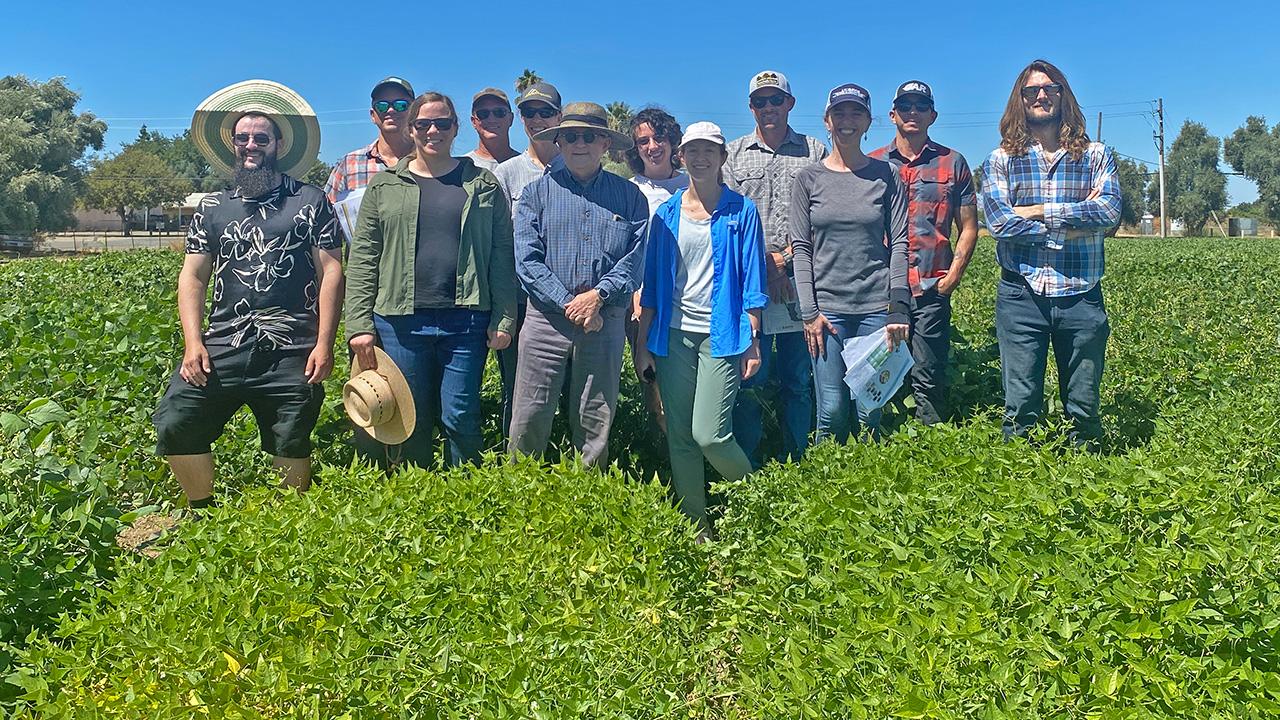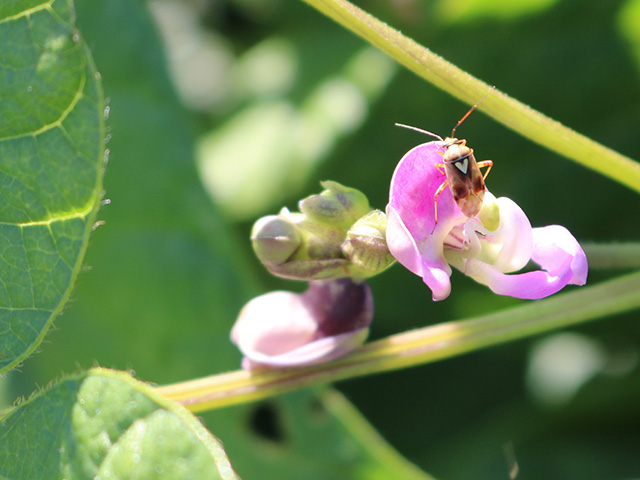
Lima bean project battles bottlenecks in breeding
Dry Bean Field Day shows latest research

Two thousand years ago, lima beans were a food reserved for warriors in the Moche culture of coastal Peru. Today, researchers at the UC Davis Department of Plant Sciences are leading a program to develop tools and resources to breed better beans faster. Their work is part of a larger effort to create new versions of the delicacy that will flourish in the United States.
But first things first: While lima beans are called that after Peru’s capital city of Lima (pronounced LEE-muh), folks in the American South and the United Kingdom call them butter beans -- a handle more likely to cause people to perk up when they hear it.
Scientists led by Paul Gepts, a distinguished professor emeritus in the department, described the problems they are trying to overcome, the research being brought to the battle and the benefits to farmers and consumers. He outlined the project during the recent University of California Dry Bean Field Day, held on campus fields in partnership with UC Cooperative Extension. The work addresses consumer attitudes, biological barriers to growing the beans in the Northern Hemisphere, and the lack of information about the beans’ traits and their genetic underpinnings. Gepts and team called these bottlenecks that, when overcome, will support nationwide breeding efforts that can lead to delicious, nutritious and climate-resilient food.
Scientists are interested because lima beans’ wild relatives in Latin America grow in a wide range of conditions of heat and cold, drought and moisture. That means they have adapted to a broad variety of conditions, and probably have evolved greater tolerance to environmental stress, than other domesticated beans. That makes them attractive for growing food as the world’s climate changes.
Farmers are interested because lima beans bring diversity to their crop mix, Gepts added. Beans have the ability to fix nitrogen in the soil, benefiting overall soil fertility and health.
“I’ve had people ask me, ‘What else can I grow?’” Gepts said. “Growers here in California have an advantage because of the irrigation and aridity of climate” The state also has a long growing season. Those conditions are good for the small, white-seeded type of limas -- baby limas -- that are thought to have been domesticated in Mexico.
Chris Capaul is a grower in Sutter County and a self-described “baby lima specialist.” “My dad grew them, and he taught me how to do it,” Capaul said. It takes constant observing and learning, he added, but the results are special: The beans he harvests bring customers driving up from Fresno just to buy a sack, they’re that good.
Researchers hope their work would mean more farmers would have an easier time growing both types, and that more consumers would enjoy them.
Consumer attitudes and perceptions

While limas are basking in recent adulation from foodies, many people have had unpleasant encounters with beans that taste chalky, starchy or bitter.
The project includes surveying consumers, chefs and food service professionals, along with growers, extension specialists and communications experts, to figure out why people have those perceptions and how to educate them about limas’ potentially great taste and nutrition.
Scientists will use feedback from surveys and sensory and culinary evaluations to help them select plants that will be used for the breeding programs, wrote Jaclyn Adaskaveg, an Aggie grad and postdoc working on the project with Gepts and Christine Diepenbrock, an assistant professor in the department.
Sensitivity to length of day
The beans themselves are built for short days and long nights, characteristic of the tropical regions where they originated. Most plants will not flower amid the long days and short nights of the North American growing season, Adaskaveg wrote. But many of the traits scientists are looking for, and need to observe in the field, develop after flowering.
However, about 10 percent of the plants do flower amid our long summer days, typically the small-seed varieties. “They do very well here,” Gepts said. The historic Irvine Ranch in Orange County, Calif., was a big lima bean growing area at the beginning of the 20th century.
So the second focus of the project is crossing the two types of beans -- those that are day-length sensitive and those that are not. In a partnership with the National Center for Genome Resources in New Mexico, breeders will use genetic information to develop new lines that are day-neutral and will bloom in northern latitudes, Gepts explained.

Seeds were provided by the United States Department of Agriculture’s seed banks, the National Plant Germplasm System, another partner in the project. “We’ve already been working with these seeds for two years, and they are highly interesting from every angle that we’ve analyzed them,” Diepenbrock said.
Plants developed in this part of the project then can be evaluated for all the traits for cultivation, nutrition, flavor and texture that scientists are looking for.
National resources set up plants for breeding program
Scientists already are sequencing the genomes of key lines of beans held in the NPGS. They want to find the areas on the genome responsible for high nutrition and helpful traits in the field, such as plant size and shape (beans grow as bushes and as vines), the number of pods a plant produces and tolerance to pests.
The work also includes growing plants in Southern California. Collaborators at the University of California, Riverside, want to screen for plants that grow well in short winter days and that resist worms.
Plants also must produce beans with high protein and pleasing levels of fiber, starch and fat, Adaskaveg wrote.
“There is still much to be discovered within and across these types of traits,” Diepenbrock said. “Overall, this project aims to boost the well-rounded improvement of lima beans to generate varieties that are well-adapted to the U.S. and preferred by farmers, processors and consumers.”
More bean research
Other research presented during Dry Bean Field Day included:

Heat tolerance in common beans: Sassoum Lo, a postdoctoral researcher in Diepenbrock’s lab, discussed her team’s work to improve heat tolerance in common beans, black-eyed peas (also called cowpeas) and tepary beans. (Tepary beans are roundish, sometimes colorful, and developed in the low-desert heat, drought-prone climate and alkaline soils of the American Southwest.) They are using genomics, sensors and 3-D models to evaluate grain yield and nutritional quality under different day lengths, temperatures and aridities. Her team includes doctoral student Jonathan Berlingeri. The project is being carried out by a large, international collaboration that includes the labs of Brian Bailey, an associate professor in the Department of Plant Sciences; Mason Earles, an assistant professor in the Department of Biological Engineering; and several partnering breeders.
Limas for California: Antonia Palkovic, an associate specialist in the department, is working with Diepenbrock and team to develop lima beans for growing in California. They hope to improve yield, seed size, seed quality and tolerance to lygus, a devastating insect pest.
Garbanzos: Palkovic and Diepenbrock also discussed garbanzo breeding: They and team are working to improve yield, seed size, seed quality and regional acclimation. Their focus is on kabuli types.
Nutrition in different regions: Tayah Bolt, a doctoral candidate in the Diepenbrock lab, described variation in nutritional traits in common beans when grown in different parts of the state: Davis, Central Coast, Central Valley and North State.
Seeds for researchers: Sarah Dohle, a Ph.D. graduate from the Gepts lab, is now curator of the lima bean seed collection for the USDA Agricultural Research Station in Pullman, Wash. The collection includes seeds collected from 17,000 spots. She described work to keep them viable and provide samples to researchers.
Black-eyed peas: Field evaluations were presented for black-eyed peas and garbanzos grown in the Central Valley.
Related links
- For more information about the UC Davis-based programs to breed lima and other beans, contact Betsy Huynh at bmthuynh@ucdavis.edu.
Other team members on the bottlenecks/breeding resources project at UC Davis include Ivan Garcia-Lopez, Varma Penmetsa and Travis Parker.
The project is funded by the USDA Specialty Crop Research Initiative. Other collaborators include the University of Delaware, Clemson University, Iowa State University and the USDA Agricultural Research Service.
Media Resources
- Trina Kleist, UC Davis Department of Plant Sciences, tkleist@ucdavis.edu, (530) 754-6148 or (530) 601-6846
